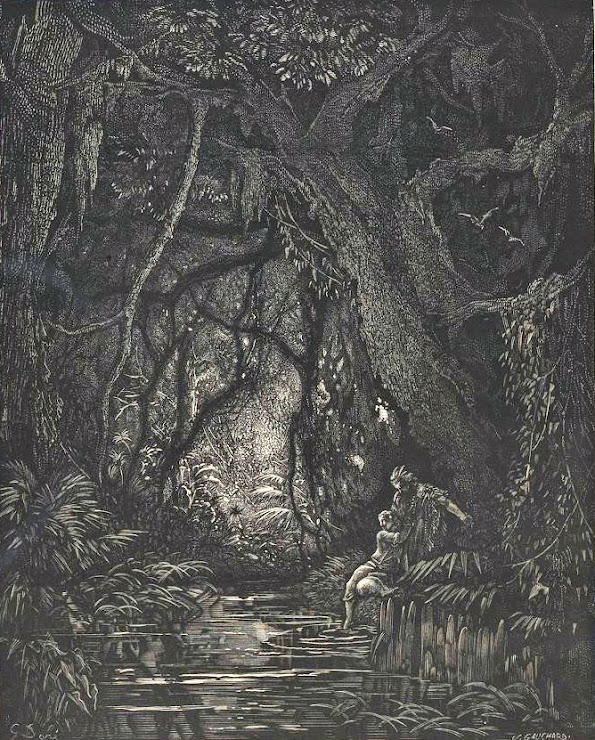Our visual image of Victorian London is largely fixated on its sordidness—cramped streets, dark alleys, desolate slums, overcrowding, and illicit dens. Two people are responsible for creating in our heads such pictures of destitution and filth—one is Charles Dickens, whose works largely revolved around grinding poverty, and the other is French illustrator Gustave Doré. Doré (1832 – 1883) was a prolific engraver, artist, illustrator, and sculptor, who became very popular both in France and England by being an extremely successful illustrator for books and magazine.
He began his career early—at the age of fifteen—working for the French paper Le journal pour rire. Before he was twenty-five, his illustrations had adorned the books of several prominent writers of his time such as Cervantes, Rabelais, Balzac, Milton, Byron, and Dante. His illustrations of Cervantes's Don Quixote left such an indelible impression on the collective imagination of the public that it forever changed how subsequent artists, stage and film directors would represent the various characters in the book in their medium. Doré's illustrations for the English Bible in 1866 was such great success that it earned him a major exhibition of his work in London, eventually leading to the foundation of his very own Dore Gallery.
In 1869, Dore teamed up with journalist Blanchard Jerrold to produce a comprehensive portrait of London. For the next four years, Jerrold and Dore explored the dark underbelly of the largest, most fashionable, and most prosperous city in the world, visiting night refuges, staying in cheap lodging houses and making rounds of the opium den. The duo were often accompanied by plain-clothes policemen. They travelled up and down the river and attended fashionable events at Lambeth Palace, the boat race and the Derby.
This is part 25 of a 25-part series on later works of Gustave Doré:
 |
| 1883 The Vale of Tears oil on canvas 412.5 x 627 cm Petit-Palais, Paris |
 |
| 1883 The Vale of Tears detail |
 |
| 1883 The Vale of Tears detail |
%20Detroit%20Institute%20of%20Arts,%20MI.jpg) |
| after 1883 The Vale of Tears engraving printed in black on chine colle 65.2 x 83.8 cm (image) Detroit Institute of Arts, MI |
Lithographs: National Gallery of Victoria, Melbourne, Australia:

An Ancient Briton Contemplating the Costume of His Descendants
lithograph
Druid Worship - a Human Sacrifice
lithograph
Racine Performed before the Court of Versailles 1695
lithograph.jpg)
Knight Errantry in the 12th Century
lithograph 19.5 x 26.8 cm (image)
The Judgement of God
lithograph
Devotion in the 5th & 6th Centuries - Fasting & Prayer
lithograph
The Lords & Ladies of the Castle - Early 16th Century
lithograph
Surprised by Watchmen - Reign of Henry IV
lithograph
After Richelieu's decree against Duelling
lithograph
A Pastoral Under Louis the XV
lithograph
Fashions Under "The Directory" 1798 - The Incroyables
lithograph
Ten Years Later, or a Change of Fashion 1840
lithograph
The Inquistion - Torture by Water
lithograph
The Jig - A Ball in the Reign of Henry III
lithograph
The final works in this series by Gustave Doré are undated, so inevitably from different periods:

n.d. A Costumed Actor in Front of a Curtain
pen and black ink, graphite, heightened with white
18.3 x 14 cm
Metropolitan Museum of Art, New York
n.d. A Rider and a Dead Horse in a Landscape
pen and black ink, brush and black ink, heightened with white on a woodblock 23.6 x 18.7 cm
Metropolitan Museum of Art, New York%20Museum%20of%20Fine%20Arts,%20Boston,%20MA.jpg)
n.d. An Exposition, Demonstrating a Bell
wood engraving 12.3 x 15 cm (image)
Museum of Fine Arts, Boston, MA%20Museum%20of%20Fine%20Arts,%20Boston,%20MA.jpg)
n.d. Child Seated on Lap of Old Man Helping Him to Sip from Chalice
wood engraving 29 x 19.6 cm (sheet)
Museum of Fine Arts, Boston, MA
n.d. Christ in Contempt
graphite, pen and India ink, heightened with white, on brown paper 63.8 x 48.2 cm
n.d. Christ's Entry into Jerusalem
oil on canvas 98.4 x 131.4 cm%20Museum%20of%20Fine%20Arts,%20Boston,%20MA.jpg)
n.d. Group Accosted in Woods by Unseen Figures with Guns
wood engraving 11 x 16.5 cm (image)
Museum of Fine Arts, Boston, MA
n.d. Jesus Preaching on the Mount
oil on canvas 130 x 196 cm
n.d. Jeune Mendiante
graphite and watercolour on paper 127 x 64.8 cm
n.d. Landscape in the Landes with Umbrella Pines
oil on canvas 80 x 130.3 cm
n.d. Le Grand Combin, French-speaking Switzerland
oil on panel 26 x 35 cm
n.d. Male Figure in Classical Costume
graphite on paper 23.4 x 24.2 cm
Metropolitan Museum of Art, New York%20Minneapolis%20Institute%20of%20Art,%20Minnesota.jpg)
n.d. Marc Anthony's Funeral Oration for Julius Cesar
pen and brown and black ink heightened with bodycolour 21.2 x 34.7 cm (image)
Minneapolis Institute of Art, Minnesota%20Museum%20of%20Fine%20Arts,%20Boston,%20MA.jpg)
n.d. Narrow French Street with Tall Figure at Doorway
wood engraving 17.8 x 6.5 cm (image)
Museum of Fine Arts, Boston, MA
n.d. Neophyte, 6th state
The New York Public Library Digital Collections%20Museum%20of%20Fine%20Arts,%20Boston,%20MA.jpg)
n.d. Nobleman Kneeling in Graveyard: Gravediggers in Background
wood engraving 11.7 x 14.5 cm (image)
Museum of Fine Arts, Boston, MA
n.d. Roger embraced by Bradamante
graphite, pen and Indian ink, heightened with white on beige paper 61 x 43 cm
n.d. Soldiers under a Tree
pen and black ink, with brush and grey wash, heightened with touches of white gouache on tan card 50.5 x 39 cm
Art Institute of Chicago, IL
n.d. Stream in Mountains at Dusk / Alpine Torrent
oil on canvas 130.8 x 195.9 cm
Detroit Institute of Arts, MI%20Fine%20Arts%20Museums%20of%20San%20Francisco,%20CA.jpg)
n.d. The Army of Angels
wood engraving 25 x 19 cm (image)
Fine Arts Museums of San Francisco, CA
n.d. The Fortune-Teller
chalk, pen and ink and body-colour 26.3 x 28.7 cm
Royal Collection Trust, UK
n.d. The Sick Stag
watercolour over graphite 3.5 x 24.8 cm
Museum of Fine Arts, Boston, MA%20Museum%20of%20Fine%20Arts,%20Boston,%20MA.jpg)
n.d. Turbaned figure wrapped in cloth, lying on ground
wood engraving 3.4 x 8 cm (image)
Museum of Fine Arts, Boston, MA
n.d. Two Owls
oil on canvas
Private Collection
































































